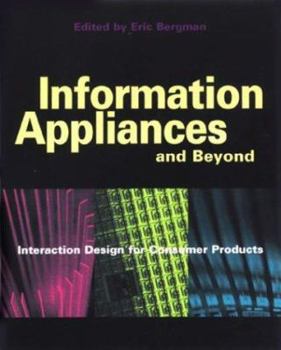Information Appliances and Beyond: Interaction Design for Consumer Products (Interactive Technologies)
A growing focus on product usability is creating demand for usability specialists and prompting companies of all kinds to hire developers and designers who are well versed in this way of thinking.... This description may be from another edition of this product.
Format:Paperback
Language:English
ISBN:1558606009
ISBN13:9781558606005
Release Date:March 2000
Publisher:Morgan Kaufmann
Length:400 Pages
Weight:1.60 lbs.
Dimensions:9.3" x 0.8" x 7.5"
Customer Reviews
4 ratings
Engaging Collection of Interface Design Case Studies
Published by Thriftbooks.com User , 16 years ago
My favorite mental image from this book is a Palm Pilot designer walking through his office pretending to write on a block of wood. It communicates the essence of contextual design to both experienced and novice designers. Bergman's collection of case studies illustrates basic interface design principles while making a strong case that PDAs, mobile phones, and even children's toys require fresh thinking about design. Information appliances are specialized devices requiring more focused design than general-purpose PCs. The first chapter, an interview with design expert Don Norman, highlights differences between PCs and information appliances. Norman hopes that computers will largely "disappear" as they are embedded in these special-purpose tools. The second chapter is an information appliance design tutorial. It advocates five design principles: (1) focus on the task domain; (2) customize the user interface; (3) configure functions according to frequency and importance of use; (4) simplify to a small set of core functions; and (5) design for interruptability and continuous feedback. In subsequent chapters, designers answer Bergman's question: "What is different about designing software in this domain than designing software for a desktop computer?" Chapter 3 discusses "Internet appliances" designed for broad appeal and accessibility through the web. A key challenge is presenting content "to suit the tastes, requirements, and device limitations" of such a large audience. Chapter 4 is a conversation with a member of the Palm Pilot design team, filled with examples of design and redesign. Chapters 5 and 6 describe the design of Microsoft Windows CE and the EPOC interface in the Psion Series 5, two efforts to design scaled-down personal computers. They represent very different perspectives on how closely designers should model the familiar PC interface. Chapter 7 covers design issues for portable communication devices and includes an excellent overview of the contextual design process. The importance of social and cultural factors in mobile phone design is a key lesson. Chapter 8 is a case study of vehicle navigation system design. It showcases five conceptual components of user interface design: metaphors, mental models, navigation, appearance and interaction. Chapter 9 reminds us that toy design is about fun rather than efficiency. Chapter 10 laments the lack of communication between game designers and the mainstream design community. Game designers understand the importance of emotional engagement and appropriate pacing. The final chapter discusses design of "persuasive technologies," which attempt to change user attitudes about such topics as safety, health, and personal relationships. It also explores the effects of connecting information appliances to wider networks to access current information and make real-time reports. The chapters are well organized and readable. The contributors make effective use of "before" and "after" interface
A superb book
Published by Thriftbooks.com User , 25 years ago
Many information technology designers forget that the purpose of product design is not to display technical virtuosity, it is to help their users solve problems in the real world. This book, alone among those I've read, confronts this issue in a compelling and useful way. It's a "must read" for anyone thinking seriously about how to design information products.
Excellent book, especially for designers
Published by Thriftbooks.com User , 25 years ago
In this book, Eric Bergman surveys some of the most influential and thoughtful people in the user interface design world - Don Norman, Chuck Clanton, David Haitani (designer of the Palm Pilot) and more. Their comments are insightful, practical, and visionary at the same time. I particularly liked the chapters by David Haitani and the one by Chuck Clanton on computer game design. This book will be helpful to anyone who has designed software user interfaces for desktop machines or web sites and is now wondering what the brave new world of wireless devices might look like.I find that I like read the chapters in order of what interests me, not necessarily in the order they are bound together in the book. And that is a strength of the book - it acts more like a reference than like a novel. In this way, it reminds me of Brenda Laurel's excellent book "The Art of Human Computer Interaction."
Great book on a important topic
Published by Thriftbooks.com User , 25 years ago
Well written and interesting to read, Information Appliances & Beyond is the lone book (at least that I've come across) that helps product designers create Information Appliances. The Interview with the creator of the Palm Pilot is excellent, as are the examples of the Nokia 7110 mobile phone, and the i-opener. Highly recommended to anyone with an interest in the future of consumer computing.





